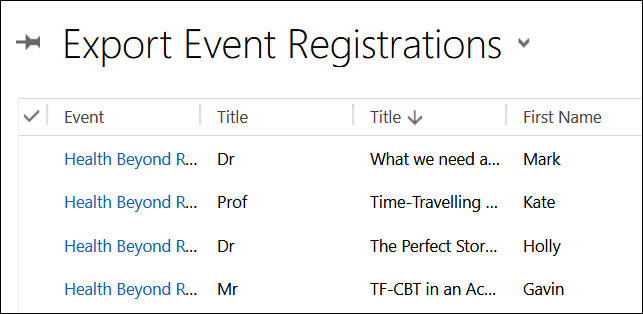

Tap and hold or right click on a message to open the message action menu.

Open Microsoft Teams and go to the chat with the message you want to delete. These messages will be removed from everyone’s view. In Teams, you can only delete messages you have sent to others. To delete your messages and media from chat: Learn more about deleting a chat in Teams.

Select Delete and confirm on the resulting dialog. On Windows, Mac, and web, right click on the chat. On iOS devices, swipe left on the chat then tap More.
#TEAMSID EXPORT RECORDS ANDROID#
On Android devices, tap and hold the chat. The chat will be removed from your view but may still be visible to others. In Teams, you can delete a chat conversation. Learn more about how to delete a community.
#TEAMSID EXPORT RECORDS DOWNLOAD#
Select the Download button to download your files. You will need to check back periodically to the export page on the status of your export, which you can see at the top of the page under Available Exports. A link to download your files will also appear there when they are available to download. Select the option to download your Chat history, Media, or both, and then select Submit request. Select Continue when prompted. Sign in to the Export page with your Microsoft Account. INNER JOIN ServiceUsers s ON t.UserID = s.To export your messages and media from chat and community: SELECT Teams.UserID, First(Teams.ID) AS FirstOfID,įirst(Teams.TeamID) AS ATeamID, "2nd" As TeamCount TRANSFORM First(t.ATeamID) AS FirstOfATeamIDįROM (SELECT Teams.UserID, First(Teams.ID) AS FirstOfID,įirst(Teams.TeamID) AS ATeamID, "1st" As TeamCount It should be possible to combine the two queries and to use a union query to reduce the number of entries. INNER JOIN Teams ON ServiceUsers.ID = Teams.UserID Ĭrosstab TRANSFORM First(TeamUser.TeamID) AS FirstOfTeamID Query 1: Called TeamUser SELECT Teams.UserID, ServiceUsers.SName, Teams.TeamID Obviously, with a big number of rows performance would be terrible, but for a few hundreds it could be acceptable. You can choose another order by changing the TeamList query, but the field you choose must have different unique values for each Team (or the <= comparison will generate wrong numbers). You could assemble all this in a single query, but it's more practical to define the TeamList query and calling it multiple times.Īlso note that this way the numbering is based on the order of TeamID. (SELECT TeamID FROM TeamList WHERE UserTable.ID = TeamList.UserID AND position=2) As Team2, (SELECT TeamID FROM TeamList WHERE UserTable.ID = TeamList.UserID AND position=1) As Team1, Now, you can use this query in the main query, by calling it 7 times, each time filtering a different position: SELECT UserTable.ID As UID, UserTable.Name, (SELECT count(*) FROM TeamTable t2 WHERE t2.TeamID <= TeamTable.TeamID and t2.UserID=TeamTable.UserID) AS position values from an jet query?įirst, you need a query to assign a number from 1 to N to the teams associated to a user: SELECT UserID, TeamID,
#TEAMSID EXPORT RECORDS HOW TO#
An ideas on how to skip the first/second/etc. SELECT UserTable.ID As UID, UserTable.Name,ĪND TeamID Team1 ORDER BY TeamID) As Team2 (SELECT TOP 1 TeamID FROM TeamTable WHERE UserTable.ID = TeamTable.UserID SELECT UserTable.ID As UID, UserTable.Name, If there are more teams than columns, only the first 7 teams will be shown in this summary.Įdit 2 - Possible solution which doesn't work.: If there are less teams than columns the additional columns should be Null (as in example). (Yes, I know that if there are more teams assigned to a user than I create columns the query will lose that information: that isn't a concern).Įdit: To clarify, the number of columns in the query will be fixed (in the actual query, there will always be 7). I can get the Team1 column using max() from a sub select query, but I'm having a complete mental block on how to achieve Team2, Team3, etc. I need to produce a summary query that produces a single row for each user, with the first several teams (by TeamID) assigned sitting in separate columns. Teams providing services: | ID | TeamID | UserID | Service Users: | ID | Name | Other details. Say we have two tables in an MS Access db:


 0 kommentar(er)
0 kommentar(er)
